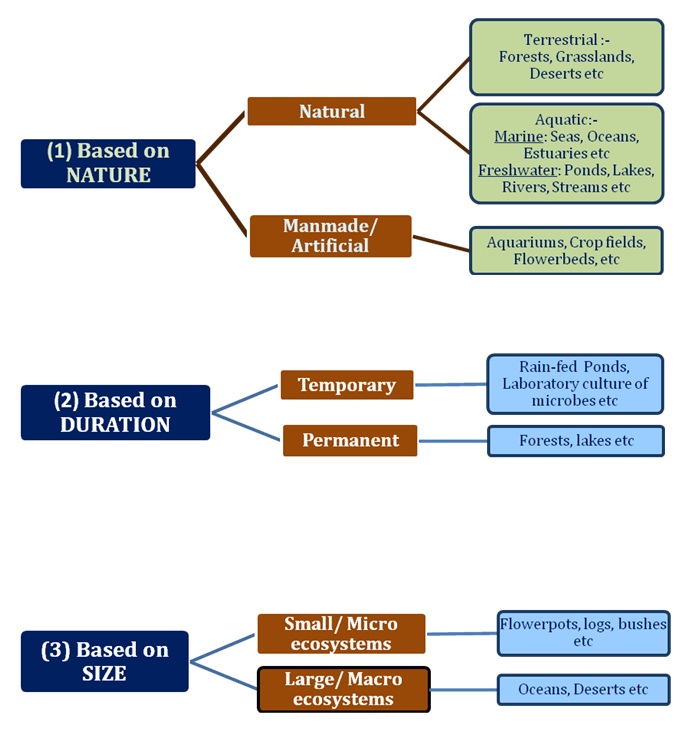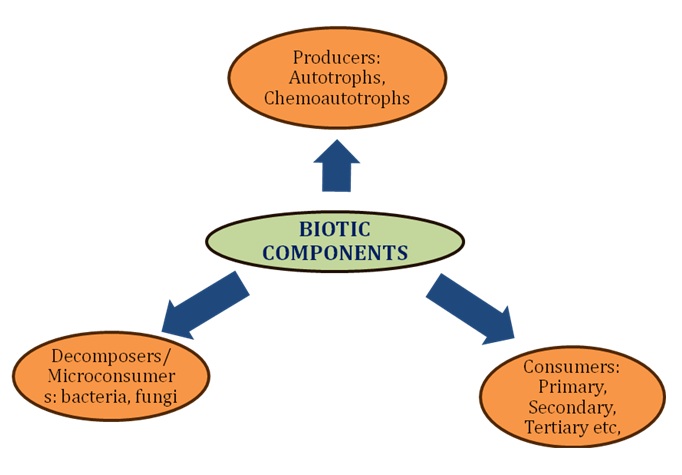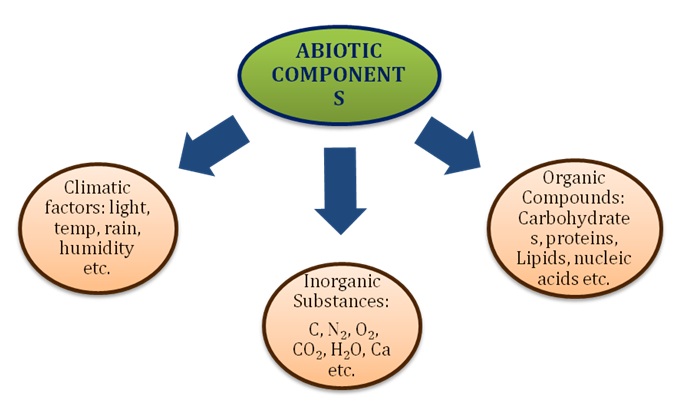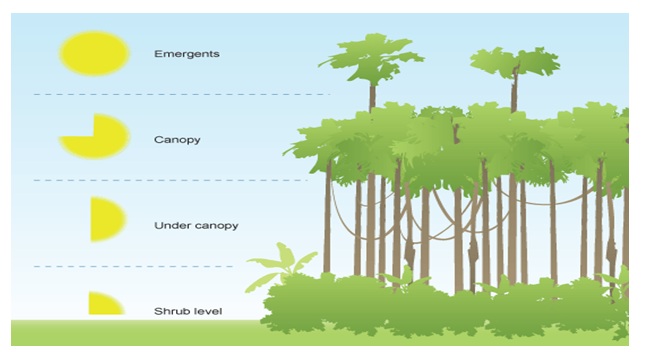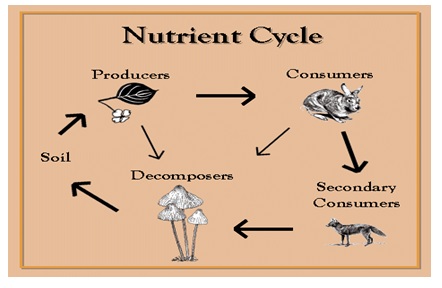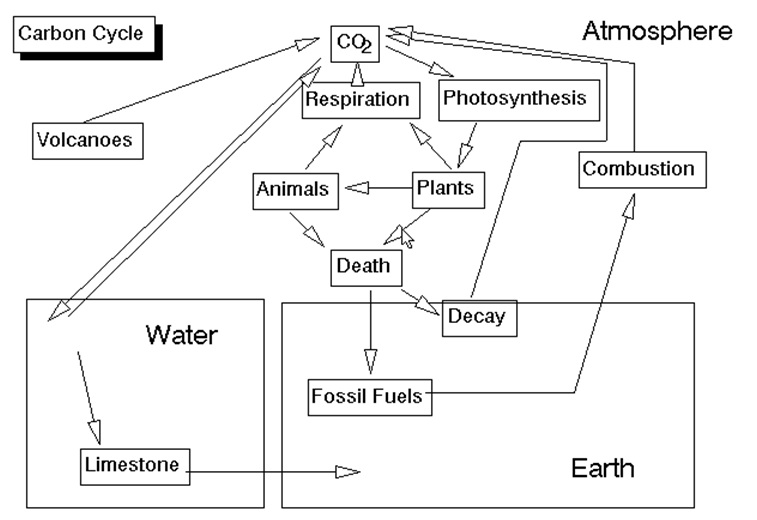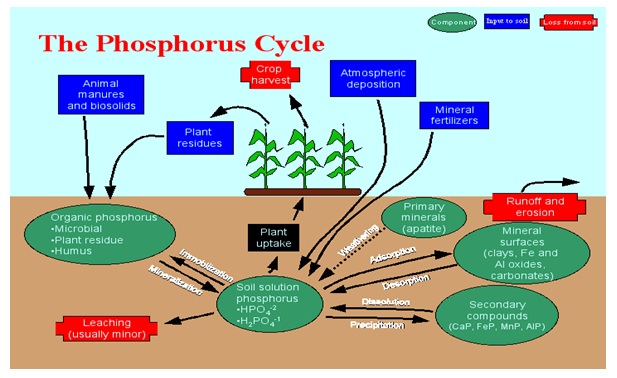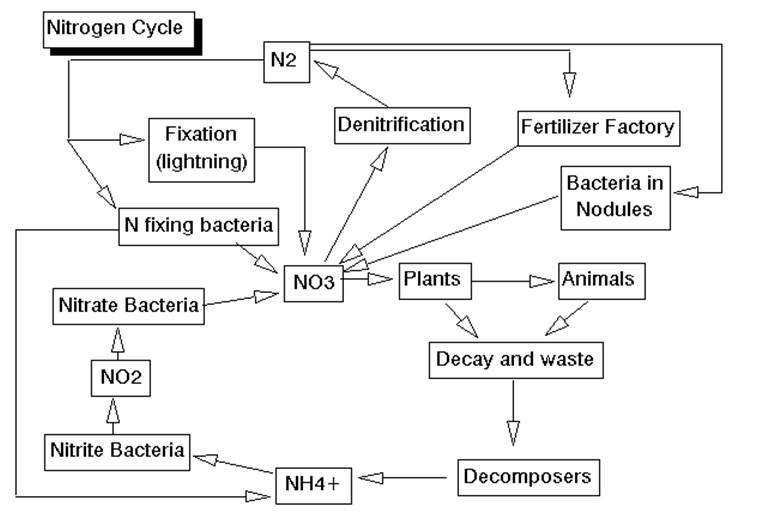CHAPTER – 14 : ECOSYSTEM
British ecologist Arthur Tansley first defined the term Ecosystem.
ECOSYSTEM :- the functional unit of nature, where living organisms interact among themselves and with the surrounding physical environment.
Types of Ecosystems:
New Species Discovered in Different Ecosystems:
· Pinocchio: long nosed frog found in Indonesia
· Bald headed parrot in Amazon
· Yeti Crab (Kiwa hirsuta) near Easter islands.
Structure of Ecosystems
An Ecosystem has two components:
· Biotic components and
· Abiotic components
· Pinocchio: long nosed frog found in Indonesia
· Bald headed parrot in Amazon
· Yeti Crab (Kiwa hirsuta) near Easter islands.
Structure of Ecosystems
An Ecosystem has two components:
· Biotic components and
· Abiotic components
Stratification:
This is the Vertical Distribution of Different Species occupying Different Levels.
The levels are called STRATA.
This is the Vertical Distribution of Different Species occupying Different Levels.
The levels are called STRATA.
Aspects Affecting the Functioning of an Ecosystem are:
1. PRODUCTIVITY
The rate of synthesis of organic matter (biomass) during a given period of time. It is measured as weight (g-2) or as energy (kcal m-2). It is used to compare productivity of different ecosystems.
GPP – R = NPP
*GPP-Gross Primary Productivity *NPP-Net Primary Productivity
2. DECOMPOSITION
It is the process of breaking down of dead organic matter into smaller organic molecules and inorganic molecules by Decomposers (bacteria, fungi)
DETRITUS: Dead remains of plants and animals is called detritus.
DETRITIVORES: Animals that feed on decaying organic matter (detritus).
Examples: earthworms, termites, snails etc
Mechanism of Decomposition:
- Highly resistant to Microbial Action
- Undergoes Decomposition very Slowly.
- Reservoir of nutrients (due to colloidal nature)
5. Mineralisation: Humus is degraded – releases inorganic substances
( CO2, H2O etc) and nutrients (Ca2+, Mg2+,K+ etc)
Factors affecting rate of Decomposition:
3. ENERGY FLOW
► SUN- Main Source of energy
► 50% of incident light is PHOTOSYNTHETICALLY ACTIVE RADIATION (PAR)
► 2- 10 % of PAR is captured by plants.
► Only a small fraction of this (stored as organic compounds) is transferred to consumers; the rest is used up in respiration and other life-supporting activities of the plants.
► As energy is transferred as food, most part is lost as heat at each stage (10% LAW)
Unidirectional flow of Energy:
Sun -> Producers -> Consumers
Transfer of energy / food from the producer through a series of organisms is known as FOOD CHAINS.
FOOD CHAINS
1.GRAZING FOOD CHAIN (GFC)
2) DETRITUS FOOD CHAIN (DFC)
· Primary source of energy is Detritus.
· First trophic level includes Detritivores.
· Detritus Food Chains are small-sized chains.
SAPROPHYTES:These include decomposers (fungi, bacteria) which feed on detritus.
FOOD WEBS
• The Natural Interconnection of Several Food Chains forms a FOOD WEB.
• Provides alternate pathways for food availability.
• Unlike food chains, food webs are never straight.
• Help in ecosystem development and stability.
TEN PERCENT LAW:
Ø By Lindemann in 1942
Ø States that : during transfer of energy from one trophic level to another, only about 10% is stored at higher levels; remaining 90% is lost in respiration (heat)
4. ECOLOGICAL PYRAMIDS
2. Pyramid of Biomass
3. Pyramid of energy
b) Inverted (in case of pond ecosystem)
3. Pyramid of energy: The relationship between producers and consumers in an ecosystem can be represented in the form of a pyramid in terms of flow of energy called pyramid of energy. It is always upright.
Learn more from your teachers in class along with diagram
Limitations of Ecological Pyramids:
Climax Community:
Ecological Succession:
Seral Communities:
Hydrosere - Community in freshwater
Lithosere - Community on rock
Pssamosere - Community on sand
Halosere - Community in saline body
Xerosere - Community in dry area
Primary Succession
- a lava flow
- glacial tills
- newly formed lake,
Secondary Succession
- cut-over forest
- natural forces such as wind storms and floods
Succession in Plants:
Hydrarch succession
Xerarch succession
The Nutrient Cycle
- Sedimentary cycle
Ecosystem Services1. PRODUCTIVITY
The rate of synthesis of organic matter (biomass) during a given period of time. It is measured as weight (g-2) or as energy (kcal m-2). It is used to compare productivity of different ecosystems.
- Primary productivity:
GPP – R = NPP
*GPP-Gross Primary Productivity *NPP-Net Primary Productivity
- Secondary productivity
2. DECOMPOSITION
It is the process of breaking down of dead organic matter into smaller organic molecules and inorganic molecules by Decomposers (bacteria, fungi)
DETRITUS: Dead remains of plants and animals is called detritus.
DETRITIVORES: Animals that feed on decaying organic matter (detritus).
Examples: earthworms, termites, snails etc
Mechanism of Decomposition:
- Fragmentation of Detritus: Detritivores feed on detritus ---breakdown --- increases the surface area of detritus particles for microbial action.
- Leaching: Soluble inorganic nutrients dissolve in water -– percolate through the soil ---removed due to leaching action.
- Catabolism: Decomposers (bacteria, fungi) release enzymes --- decompose detritus --- simpler inorganic compounds.
- Humification: Simplified detritus--- converted to HUMUS
- Highly resistant to Microbial Action
- Undergoes Decomposition very Slowly.
- Reservoir of nutrients (due to colloidal nature)
5. Mineralisation: Humus is degraded – releases inorganic substances
( CO2, H2O etc) and nutrients (Ca2+, Mg2+,K+ etc)
Factors affecting rate of Decomposition:
- Chemical composition - decomposition rate will be slow when detritus is rich in lignin and chitin and rate increases when detritus is rich in nitrogen and water soluble substances like sugsrs.
- Climatic conditions – warm and moist environment favour decomposition and low temperature and anaerobiosis inhibit decomposition.
3. ENERGY FLOW
► SUN- Main Source of energy
► 50% of incident light is PHOTOSYNTHETICALLY ACTIVE RADIATION (PAR)
► 2- 10 % of PAR is captured by plants.
► Only a small fraction of this (stored as organic compounds) is transferred to consumers; the rest is used up in respiration and other life-supporting activities of the plants.
► As energy is transferred as food, most part is lost as heat at each stage (10% LAW)
Unidirectional flow of Energy:
Sun -> Producers -> Consumers
Transfer of energy / food from the producer through a series of organisms is known as FOOD CHAINS.
FOOD CHAINS
- Food chains represent energy flow through ecosystems.
- Different steps in a food chain are TROPHIC LEVELS
- Basic terms:
1.GRAZING FOOD CHAIN (GFC)
- Primary source of energy - Solar radiations.
- First trophic level includes - All Herbivores.
- -GFCs are Long-sized chains
2) DETRITUS FOOD CHAIN (DFC)
· Primary source of energy is Detritus.
· First trophic level includes Detritivores.
· Detritus Food Chains are small-sized chains.
SAPROPHYTES:These include decomposers (fungi, bacteria) which feed on detritus.
FOOD WEBS
• The Natural Interconnection of Several Food Chains forms a FOOD WEB.
• Provides alternate pathways for food availability.
• Unlike food chains, food webs are never straight.
• Help in ecosystem development and stability.
TEN PERCENT LAW:
Ø By Lindemann in 1942
Ø States that : during transfer of energy from one trophic level to another, only about 10% is stored at higher levels; remaining 90% is lost in respiration (heat)
4. ECOLOGICAL PYRAMIDS
- Developed by Charles Elton in 1927.
- Pyramids are an expression of the relationship between organisms at different trophic levels in terms of their number, biomass or energy.
- Three types of pyramids:
2. Pyramid of Biomass
3. Pyramid of energy
- Pyramid of Number: The relationship between producers and consumers in an ecosystem can be represented in the form of a pyramid in terms of number called pyramid of number.
- Pyramid of Biomass: The relationship between producers and consumers in an ecosystem can be represented in the form of a pyramid in terms of biomass called pyramid of biomass. It can be of two types:
b) Inverted (in case of pond ecosystem)
3. Pyramid of energy: The relationship between producers and consumers in an ecosystem can be represented in the form of a pyramid in terms of flow of energy called pyramid of energy. It is always upright.
Learn more from your teachers in class along with diagram
Limitations of Ecological Pyramids:
- ž It does NOT consider the same species belonging to two or more trophic levels.
- ž It is based on simple food chains, which hardly exist. It does NOT accommodate food webs.
- ž Saprophytes (decomposers) are NOT given any place in the ecosystem.
Climax Community:
- Changes that lead finally to a community that is in near equilibrium with the environment.
- It remains stable as long as the environment remains unchanged.
Ecological Succession:
- Refers to predictable and orderly change in the composition or structure of a community.
- May be initiated either by formation of new, unoccupied habitat or by some form of disturbance of an existing community.
- Sere – entire sequence of community that successively change in a given area.
- Seral stages – individual transitional communities.
Seral Communities:
Hydrosere - Community in freshwater
Lithosere - Community on rock
Pssamosere - Community on sand
Halosere - Community in saline body
Xerosere - Community in dry area
Primary Succession
- If the development begins on an area that has not been previously occupied by a community.
- Pioneer species – lichens, phytoplankton, etc.
- Examples:
- a lava flow
- glacial tills
- newly formed lake,
Secondary Succession
- If the community development is proceeding in an area from which a community was removed.
- Pioneer species – grasses, wildflowers, algae.
- Examples:
- cut-over forest
- natural forces such as wind storms and floods
Succession in Plants:
Hydrarch succession
- It takes place in wetter areas and the successional series progress from hydric to the mesic conditions.
Xerarch succession
- It takes place in dry areas and the series progress from xeric to mesic condition.
The Nutrient Cycle
- Also known as biogeochemical cycle.
- Environmental factors like soil, moisture, temperature, etc. regulate the rate of release of nutrients into the atmosphere.
- Standing state – amount of nutrients, such as C, N, P, Ca, etc. present in the soil at any given time.
- Nutrients are never lost from the ecosystem; they are recycled time an again indefinitely.
- There are two types:
- Sedimentary cycle
- Humankind benefits from a multitude of resources and processes that are supplied by natural ecosystems. Collectively, these benefits are known as ecosystem services.
- Purify air and water
- Decomposition of waste materials
- Cycle nutrients
- Pollinate crops
- Maintain biodiversity
- Researchers have put an average price tag of US $33 trillion a year on these fundamental ecosystems services, which is largely taken for granted because they are free.
